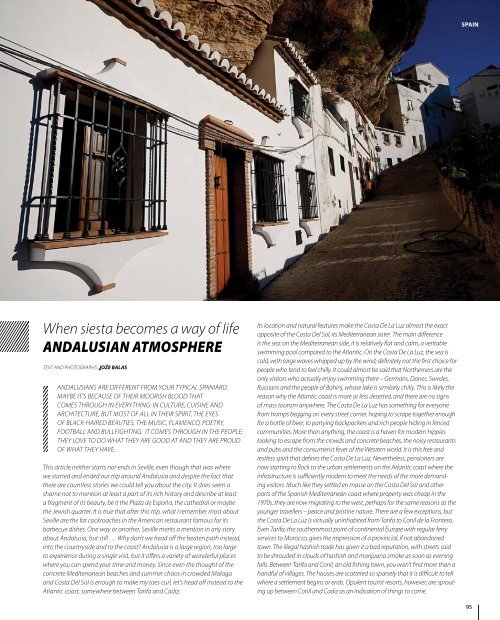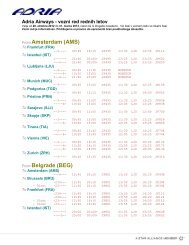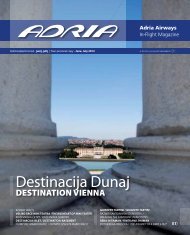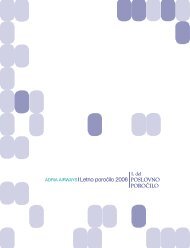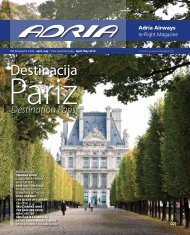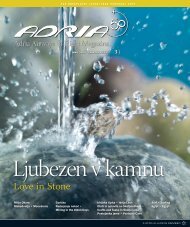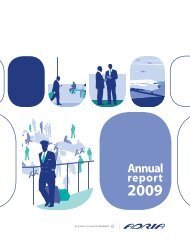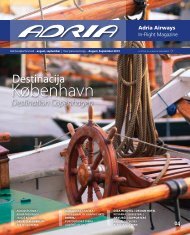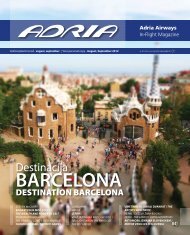Create successful ePaper yourself
Turn your PDF publications into a flip-book with our unique Google optimized e-Paper software.
SPAIN<br />
When siesta becomes a way of life<br />
ANDALUSIAN ATMOSPHERE<br />
Text and photographs: jože balas<br />
Andalusians are different from your typical Spaniard.<br />
Maybe it's because of their Moorish blood that<br />
comes through in everything: in culture, cuisine and<br />
architecture, but most of all in their spirit, the eyes<br />
of black-haired beauties, the music, flamenco, poetry,<br />
football and bullfighting. It comes through in the people;<br />
they love to do what they are good at and they are proud<br />
of what they have.<br />
This article neither starts nor ends in Seville, even though that was where<br />
we started and ended our trip around Andalusia and despite the fact that<br />
there are countless stories we could tell you about the city. It does seem a<br />
shame not to mention at least a part of its rich history and describe at least<br />
a fragment of its beauty, be it the Plaza de España, the cathedral or maybe<br />
the Jewish quarter. It is true that after this trip, what I remember most about<br />
Seville are the fat cockroaches in the American restaurant famous for its<br />
barbecue dishes. One way or another, Seville merits a mention in any story<br />
about Andalusia, but still … Why don't we head off the beaten path instead,<br />
into the countryside and to the coast Andalusia is a large region, too large<br />
to experience during a single visit, but it offers a variety of wonderful places<br />
where you can spend your time and money. Since even the thought of the<br />
concrete Mediterranean beaches and summer chaos in crowded Malaga<br />
and Costa Del Sol is enough to make my toes curl, let's head off instead to the<br />
Atlantic coast, somewhere between Tarifa and Cadiz.<br />
Its location and natural features make the Costa De La Luz almost the exact<br />
opposite of the Costa Del Sol, its Mediterranean sister. The main difference<br />
is the sea: on the Mediterranean side, it is relatively flat and calm, a veritable<br />
swimming pool compared to the Atlantic. On the Costa De La Luz, the sea is<br />
cold, with large waves whipped up by the wind; definitely not the first choice for<br />
people who tend to feel chilly. It could almost be said that Northerners are the<br />
only visitors who actually enjoy swimming there – Germans, Danes, Swedes,<br />
Russians and the people of Bohinj, whose lake is similarly chilly. This is likely the<br />
reason why the Atlantic coast is more or less deserted, and there are no signs<br />
of mass tourism anywhere. The Costa De La Luz has something for everyone<br />
from tramps begging on every street corner, hoping to scrape together enough<br />
for a bottle of beer, to partying backpackers and rich people hiding in fenced<br />
communities. More than anything, the coast is a haven for modern hippies<br />
looking to escape from the crowds and concrete beaches, the noisy restaurants<br />
and pubs and the consumerist fever of the Western world. It is this free and<br />
restless spirit that defines the Costa De La Luz. Nevertheless, pensioners are<br />
now starting to flock to the urban settlements on the Atlantic coast where the<br />
infrastructure is sufficiently modern to meet the needs of the more demanding<br />
visitors. Much like they settled en masse on the Costa Del Sol and other<br />
parts of the Spanish Mediterranean coast where property was cheap in the<br />
1970s, they are now migrating to the west, perhaps for the same reasons as the<br />
younger travellers – peace and pristine nature. There are a few exceptions, but<br />
the Costa De La Luz is virtually uninhabited from Tarifa to Conil de la Frontera.<br />
Even Tarifa, the southernmost point of continental Europe with regular ferry<br />
services to Morocco, gives the impression of a provincial, if not abandoned<br />
town. The illegal hashish trade has given it a bad reputation, with streets said<br />
to be shrouded in clouds of hashish and marijuana smoke as soon as evening<br />
falls. Between Tarifa and Conil, an old fishing town, you won't find more than a<br />
handful of villages. The houses are scattered so sparsely that it is difficult to tell<br />
where a settlement begins or ends. Opulent tourist resorts, however, are sprouting<br />
up between Conil and Cadiz as an indication of things to come.<br />
95


